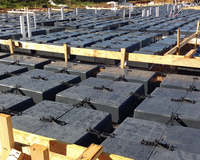While this type of foundation has been around for many years, it has recently grown in popularity due to its effectiveness in solving decade-old issues in the construction industry such as material cost, construction delays, and foundation failures.
At Wafflemat, we want you to be informed about the possible caveats of waffle slab foundations so that you may make the decision that is right for you. In this post, we will discuss the most important factors to consider when choosing if a waffle concrete slab foundation is right for your construction project.
Waffle Slab Construction Process
The process behind concrete waffle slab construction is objectively straight forward. The concrete is poured on top of void forms called Waffleboxes or waffle pods. Because the foundation is built directly on-grade, there is no trenching or off-haul of dirt necessary.
After Waffleboxes are arranged, post tensioned cables are installed in the waffle slab formwork to hold the weight. With the Wafflemat Foundation System, patented brackets guide the cables across the base, ensuring a perfect fit every time.
Because all that is required for construction of a Waffle slab is level ground, crews are able to complete the job in a matter of hours as opposed to days for other slab types.
While this can help save on time and money during the construction process, this also means that waffle slab foundations are limited to structures that will stand on level ground. This is opposed to other foundation types like crawlspace foundations which use deep in-ground footings to compensate for unlevel areas.
Concrete Waffle Slab Forms
A major difference between waffle slab designs and a traditional slab is the integration of void forms that compensate for soil movement. These forms can be made from recycled plastic, Styrofoam, or in some cases fiberglass.
The main advantage to using these forms is that they provide a pocket of air that allows for soils to expand and contract beneath the foundation. This means that where traditional foundations are susceptible to cracking, shifting, and breaking apart, waffle slab foundations are able to adapt to the always changing landscape.
Secondly, because the void forms create space under the foundation, less concrete and steel is needed to ensure rigidity. This saves the developer money in material cost and time in concrete/ steel assembly.
While waffle slab forms are easy to assemble and extremely effective in reducing waffle slab heave, there can be disadvantages to using forms in your slab foundation.
The disadvantage to using forms in your foundation is dependent on the material they are made from. Styrofoam forms which are often referred to as “waffle pods” are the worst option as they are most fragile and harmful to the environment. They require careful handling as too much pressure may cause them to crack.
To alleviate this issue, Wafflemat Foundation Systems has developed Waffleboxes which are patented forms made from recycled polypropylene plastic. This plastic type is notorious for being virtually unbreakable and can be walked upon by construction crews during the construction process, allowing for maximum accessibility.
Waffle Slab Heave
Slab heave is a term referring to the unwanted movement of a building foundation as a result of changes in soil moisture. Moisture fluctuations have been a long-standing issue in the construction industry and are a major concern across all types of traditional foundation projects.
As soils get wet, they expand, and when they dry out, they contract. This process of expansion and contraction is happening constantly under the surface of the ground. Common causes of this are from regular weather patterns, irrigation practices, poor drainage, and even roots from vegetation.
Slab heave is the reason that cracks form in walls, doors have trouble closing, and windows won’t open.

Waffle slab foundations are designed specifically to prevent slab heave. By using void forms called Waffleboxes to provide space for the soils as they shift, Wafflemat foundations can compensate for the moving landscape. Therefore, preventing structural failure and slab heave.
After 25,000,000+ square feet of concrete poured, and over 28 years in the business of foundation construction, the Wafflemat Foundation System still boasts 0 structural failures.
When it comes to slab heave with a conventional slab vs. waffle slab, waffle slab wins every time.
Conclusion
As you can see, while waffle slab foundations are growing increasingly popular in modern construction methods, they aren’t perfect for every application. There is no “one size fits all” foundation.
Our communities today are dependent on calculated solutions that solve specific problems. Wafflemat Foundation Systems are proud to provide exactly that.
With maximum rigidity and the ability to adapt to various soil conditions, this easy to build system is ideal any for single-family, multi-family, or light commercial structure needing the best foundation for expansive soil.





